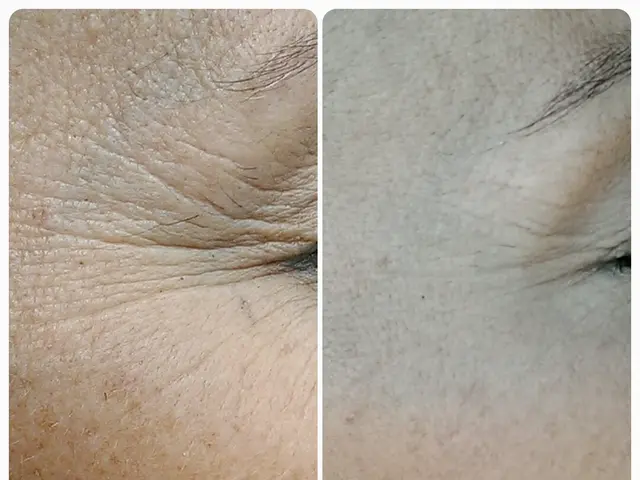Dry, scaly skin condition known as asteatotic eczema, exploring its symptoms, underlying causes, and treatment options.
Asteatotic eczema, also known as "eczema craquele", is a common skin condition that affects older adults, particularly during the colder winter months. Central heating is a major cause of this condition, leading to more people developing symptoms.
The cornerstone of home treatment for asteatotic eczema is maintaining well-hydrated skin with appropriate moisturizers and protecting the skin barrier by avoiding drying factors. Here are some effective home remedies to help manage and prevent flares of this condition.
- Regular and Intensive Moisturizing: Use thick emollients or barrier repair creams to restore skin hydration and repair the skin's protective barrier. These creams help counteract the loss of natural oils that causes the dryness and cracking seen in asteatotic eczema.
- Avoiding Hot Showers or Baths: Prolonged soaking in a hot bath can strip the skin of oils and worsen dryness. It's best to opt for lukewarm water and limit bathing time.
- Gentle Skin Care: Use fragrance-free, soap-free cleansers to reduce skin irritation and moisture loss. After bathing, pat the skin dry gently instead of rubbing to avoid further skin damage.
- Protecting the Skin: Wear gloves during housework or when exposed to water or detergents to protect the skin. Keep nails trimmed short and apply cool compresses to reduce itching and prevent scratching that worsens eczema.
- Identifying and Avoiding Triggers: Low humidity, harsh soaps, certain medications, and allergens can exacerbate skin dryness and eczema flares. It's important to identify and avoid these triggers to manage the condition effectively.
- Stress Management: Stress is a common trigger for eczema flare-ups. Managing stress through relaxation techniques, exercise, or counseling can help prevent flares.
When applying any topical natural remedies, it's advised to first do a patch test to avoid reactions, and consult a healthcare professional to ensure safety, especially in severe cases or on sensitive skin areas.
If inflammation or itching is severe, topical corticosteroids prescribed by a doctor may be necessary in addition to home remedies. Doctors may also recommend a skin biopsy for further analysis during a physical exam.
The National Eczema Association (NEA) recommends wet wrap therapy for intense itching and sleep disturbances. People with asteatotic eczema usually have patches of dry skin on their shins, but they may also have them on their back, thighs, arms, and belly.
Remember, these home care tips target the underlying cause of asteatotic eczema — loss of moisture and skin barrier damage — and focus on gentle skincare and hydration to prevent and relieve flares effectively.
Additional tips include not wearing wool or other itchy fabrics close to the skin, reducing the frequency and temperature of baths, taking additional care when using towels to avoid scratching the skin, drinking plenty of fluids, applying moisturizer immediately after bathing, switching to a milder soap, using a humidifier in centrally heated rooms, and avoiding sitting too close to a heat source.
People who sit close to their radiators or fireplaces increase their risk of developing dry skin, which can lead to asteatotic eczema. Age also plays a part in the development of this condition.
By following these home remedies and advice, you can help manage and prevent flares of asteatotic eczema, ensuring healthier, more comfortable skin during the colder months. Always consult with a healthcare professional for personalised advice and treatment.
- For asteatotic eczema, regularly use thick moisturizers like emollients or barrier repair creams to restore skin hydration and repair the skin's protective barrier.
- Prolonged soaking in hot baths can worsen dryness in asteatotic eczema, so opt for lukewarm water and limit bathing time.
- Use gentle, soap-free cleansers and pat skin dry gently after bathing to reduce skin irritation and moisture loss.
- Protecting the skin during chores or water exposure is essential; wear gloves, keep nails short, and apply cool compresses when needed.
- Identify and avoid dryness triggers such as low humidity, harsh soaps, certain medications, and allergens to manage the condition effectively.
- Stress management can help prevent eczema flares, consider relaxation techniques, exercise, or counseling to manage stress levels.
- Do a patch test before applying any topical natural remedies and consult a healthcare professional to ensure safety, particularly for severe cases or sensitive skin areas.
- In severe cases of inflammation or itching, topical corticosteroids prescribed by a doctor may be necessary in addition to home remedies.
- The National Eczema Association suggests wet wrap therapy for intense itching and sleep disturbances, although dry skin patches may appear on various body parts like shins, back, thighs, arms, and belly.




